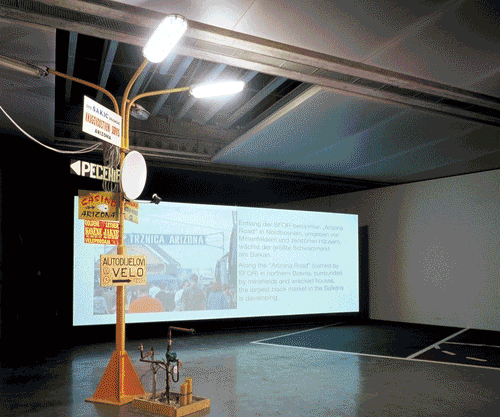
Date
Fall 2002
Place
Arizona Market, Bosnia and Herzegovina
Vienna, Austria
Medium
mixed media (poster, text, video 10 min., sculptural installation)
Design context
Produced for the Exhibition Designs for the Real World, Generali Foundation Vienna / Sep.13 -Dec.22, 2002 / Curated by Sabine Breitwieser and Hemma Schmutz
Thesis Advisors
Raoul Bunschoten, Andreas Mayer, Joost Meuwissen
Collaborator
Michael Stoiser
Video editor
Martin Heigl
Interview partner
Ilias Chatzis, Ismet Dedeić, Eamonn O`Riordan, Salih Hrnjić, Said Jamaković, Hamed Jerković, Fahrudin Selimović, Britt Tryding
Exhibition Photographs
Werner Kaligofski
Arizona Road
The project Arizona Road examines the new urban phenomena of the largest black market in the Balkans, the Arizona Market located near the city of Brčko. Arizona Road was the name given by the American military to the North-South highway in Bosnia and Herzegovina. The project focuses on the discovery and examination of new political, social, economic and urban conditions that have surfaced after the war in Bosnia. The market provides a unique opportunity to observe a birth of a city and actively shape it from an urbanistic and architectural standpoint. The co-existence of the two systems existent on the market, the formal and the informal, often leads to power conflicts. The informal, which is able to spontaneously and flexibly adapt itself to each economical and political situation, emerges mostly in cases when the formal system fails or is not able to be responsive to needs or problems of its citizens. Although they are not always distinctive, formal and informal systems simultaneously exist in every society. A formal system cannot function without its informal counterpart, and vice-versa; they supplement and react to one another. In an urban context, this proposition implies a new kind of thinking about an architect’s impact on the evolution of the city. It suggests that directed assimilation of informal activities (chaos) can become a tool for achieving more formality (order). Therefore, urban planning can be seen as a rhizomatic interweaving of actions and programs that come from both, the formal and the informal systems.
As a result of such integration, a new and unpredictable process of urban communication emerges—the process I am terming Urban Navigation. It thus calls for a balance between formal and informal urbanism. The role of the architect is consequently redefined as well: he/she is a sensor, a provoker, and a guide through urban processes which do not result in a final order, but are left open-ended. Architectural intervention thus accompanies and inspires the ever-evolving process of sustainable urban development. The Arizona Road project proposed project is questioning the efficiency of the master plan developed by the government that is threatening the further existence of the market people by turning it into a shopping mall and an entertainment center. Rather, I am proposing a so-called Provocative Pole, an infrastructural element for electricity, water, canalization, TV and advertisement. In this context, the Urban Navigation can be understood as a method of informal provocation. It uses existing conditions to create new ones which the next generation has to come to terms with—this cycle continuously reshapes urban conditions and communication processes. The aim of the project is not the development of a new order, but rather the advocacy of a self-organization indicating the acceptance of effective chaos, granting potential growth and fostering fresh urban solutions while allowing for failure.